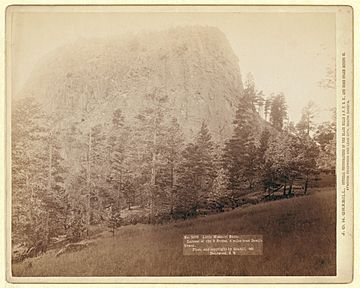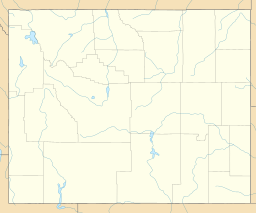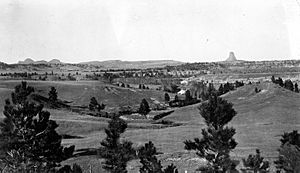Missouri Buttes facts for kids
Quick facts for kids Missouri Buttes |
|
|---|---|

Little Missouri Butte, The tallest of the buttes, as seen in 1890
|
|
| Highest point | |
| Elevation | 5,374 ft (1,638 m) |
| Prominence | 1,204 ft (367 m) |
| Geography | |
| Parent range | Black Hills |
| Topo map | USGS Missouri Buttes, WY |
The Missouri Buttes are a group of interesting rock formations located in Crook County, Wyoming. You can find them in the northeast part of Wyoming, on the edge of the Black Hills. These buttes are about 3.5 miles (5.6 km) northwest of the famous Devils Tower. They stand tall between two rivers, the Little Missouri River and the Belle Fourche River.
What are the Missouri Buttes?
The Missouri Buttes are made up of four separate peaks. These peaks rise from a flatter area called the Butte Divide, which is about 4,650 feet (1,417 meters) high. The four peaks form a rough rectangle, measuring about 0.5 by 0.65 miles (0.8 by 1.0 km).
How Tall are the Buttes?
The tallest of the four peaks is the northwest butte. It reaches an elevation of 5,374 feet (1,638 meters). The northeast butte is 5,212 feet (1,589 meters) tall. The southwest butte stands at 5,020 feet (1,530 meters). Finally, the southeast butte is 5,055 feet (1,541 meters) high. Just west of the buttes, there is a small body of water called Missouri Buttes Lake.
How Did the Missouri Buttes Form?
Like the nearby Devils Tower, the Missouri Buttes are made of a special type of volcanic rock. This rock is called phonolite. It formed deep underground from molten rock, or magma. As the magma cooled, it created unique vertical cracks. These cracks are known as columnar jointing. This makes the rock look like it's made of many tall, often hexagonal, columns stacked together.
Scientists believe the buttes were once part of a larger underground rock formation. This could have been a laccolith, which is like a giant dome of magma that pushed up the layers of rock above it. Or, they might have been a magmatic stock or even the conduits (pipes) of ancient volcanoes. Over millions of years, the softer rocks around these hard phonolite formations wore away. This process, called erosion, left the tougher Missouri Buttes standing tall and exposed for us to see today.




